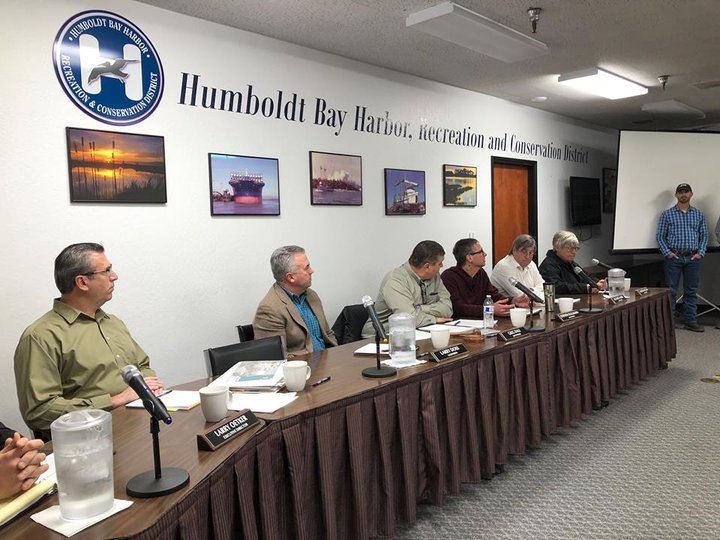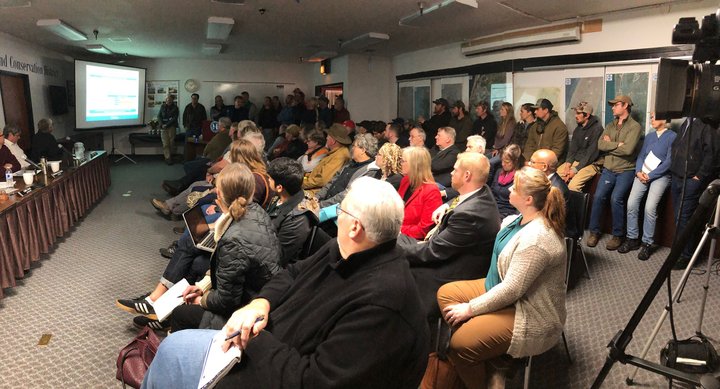UPDATE, Feb. 12, 9:50 a.m.: Here’s a copy (pdf) of the lease itself.
# # #
Original post:

Harbor District Executive Director Larry Oetker (left) with the District’s Board of Commissioners (from left) Larry Doss, Greg Dale, Stephen Kullmann, Richard Marks, and Patrick Higgins. | Photos by Ryan Burns.
In a move that could represent the dawn of a new era on Humboldt Bay, the Harbor District’s Board of Commissioners today agreed to lease roughly 30 acres on the Samoa peninsula to a Norwegian company that plans to build a massive, land-based fish farm on property that used to house a pollution-spewing pulp mill.
In a packed conference room at Woodley Island Marina, the board emerged from a special closed session meeting to disclose the terms of the lease and to take public comments. While there was some skepticism from the local fishing community, there was also a lot of excitement and optimism among attendees, and at the end of the meeting the commissioners approved the lease agreement unanimously.
Here are the terms, as explained by Harbor District Executive Director Larry Oetker:
The lease, to be signed with a subsidiary of Nordic Aquafarms called California Marine Investment Corporation, will have a 30-year term with two 10-year automatic extensions.
That long-term deal will be preceded by an “option or planning period” of up to three years, Oetker said, during which time the company will pursue all necessary coastal development permits for the aquaculture facility as well as use of the property’s existing ocean outfall pipe, which will pump treated wastewater a mile-and-a-half offshore.
During the initial option period, California Marine Investment Corporation will pay the Harbor District $20,000 per year. (The District can still use the property during this period.) Once the full lease period kicks in, the company will pay the Harbor District $500,000, and rent will jump to roughly $159,000 per year. On top of that the company will pay another $8,200 to $17,700 per year, depending on which of three development options it winds up choosing.
Some more details:
- The lease doesn’t include the existing main building at Redwood Marine Terminal II (site of the former pulp mill), which currently houses 18 commercial tenants.
- For an additional cost, which wasn’t disclosed at today’s meeting, the District will allow the fish farm to discharge up to six million gallons per day through the District-owned outfall pipe, which has a capacity of 30 million gallons per day. “Still plenty for other users,” Oetker said.
- The Harbor District agreed to remove all the miscellaneous above-ground debris at the proposed building site and either remove or replace the pulp mill’s old machine building (not to be confused with the big smokestack, whose removal will be up to the new tenants).
- There’s an electric substation on the property, and as part of the lease the District will allow the company to use 18 megawatts of its 20-megawatt capacity. “The district will retain the other two,” Oetker said. “If we choose in the future we could expand the capacity at our own expense.”
- The fish farm will have access to the existing infrastructure for freshwater supplied by the Humboldt Bay Municipal Water District, which provided massive volumes of water to the pulp mill for decades. They’ll also have access to the 2 million gallon freshwater storage tank onsite.
- The company has through March of 2020 to apply for its coastal development permits. The permit for the outfall line will have to go through the California Coastal Commission while the land-based developments fall within the county’s purview.
- The financial terms of the lease will increase annually based on the consumer price index along the West Coast.
After Oetker ran through these details, Division Five Commissioner Patrick Higgins addressed the crowd in an apparent effort to allay some anticipated fears. A fish biologist by trade, Higgins said he has strongly opposed Atlantic salmon net pen aquaculture on due to its propensity for disease transmission, its use of antibiotics, the nutrient enrichment of the environment, and the the fact that it produces “a really poor product.”
“This is a wholly different enterprise,” Higgins said. “This is self-contained. This has treated wastewater that goes out the outfall [line]. Nothing goes into the bay. There’s no chance for fish escaping into the wild. There’s no problems with disease because they’re going to use ozone instead of antibiotics. …This is a healthy product that they’re putting out.”
Division Three Commissioner Stephen Kullmann said there is still plenty of time for public feedback and regulatory review. “I just want to reaffirm that this is the beginning of a due diligence period,” he said. “This is a land deal that we’re doing, essentially … .”
Richard Marks, the commissioner representing Division Four, reminded the crowd of the polluting legacy of the pulp mill and suggested that this new development could boost other aquaculture projects that could transform Humboldt Bay into “a major aquaculture hub on the West Coast.”
And Division One Commissioner Larry Doss invited people to look further into Nordic Aquafarms, which, as one fisherman in attendance pointed out, is a fairly new company that has yet to bring a farmed fish to market, though it has three farms in various stages of development in three different countries. (Erik Heim, the founder and president of the company, noted that fish farms utilizing Recirculating Aquaculture Systems (RAS) are a fairly new development and touted his employees’ engineering accomplishments.)
“It really, to me, it seems like the perfect potential business,” Doss said before reiterating that this was just the first step in a long process. But things look good so far, he said. “It doesn’t look like it’s going to conflict with the local fishermen. It looks thumbs-up across the board.”
Heim then gave a brief presentation about his company, the state of the global fishing industry, and the technology involved in this proposed fish farm.
Here’s a video from that presentation showing how Recirculating Aquaculture Systems function:
Nordic Aquafarms Concept from Netron on Vimeo.
The Outpost will have much, much more on this project, including some of the community feedback from today’s meeting, in the coming days, weeks and months. Stay tuned.

# # #
PREVIOUSLY:
- Massive New Fish Farm in the Works for Samoa Peninsula; Harbor District Expected to Bless Project Helmed by Norwegian Firm at Special Meeting Monday
- Norwegian Fish Farm Says Its Samoa Operations Will Create 80 Jobs, Produce 50 Million Pounds of Salmon or Steelhead Per Year
- Humboldt Baykeeper Says: Samoa Fish Farm Proposal Looks Good So Far, But the Devil Will Be in the Details
CLICK TO MANAGE